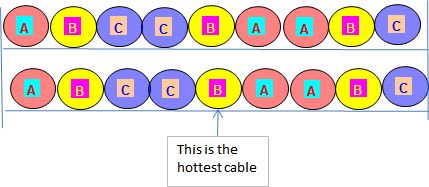Dear All,
Power cables installed beside each other, can not tolerate as much current as a single piece of cable.
It is due to thermal effect of each cable on the others.
IEC 60364 and IEC 60502 have specified correction factors for such arrangements.
I am going to put two layers of cables inside underground trench.
Trench will be filled by fine sand. Vertical distance between layers will be 20 cm. Each layer includes 9 cables.
IEC guides me about grouping correction factor for 9 cables in a single layer. But it has nothing about TWO UNDERGROUND LAYERS.
Would you please let me know the correct method? Certainly many people have seen such problem, when sizing their cables.
Power cables installed beside each other, can not tolerate as much current as a single piece of cable.
It is due to thermal effect of each cable on the others.
IEC 60364 and IEC 60502 have specified correction factors for such arrangements.
I am going to put two layers of cables inside underground trench.
Trench will be filled by fine sand. Vertical distance between layers will be 20 cm. Each layer includes 9 cables.
IEC guides me about grouping correction factor for 9 cables in a single layer. But it has nothing about TWO UNDERGROUND LAYERS.
Would you please let me know the correct method? Certainly many people have seen such problem, when sizing their cables.

